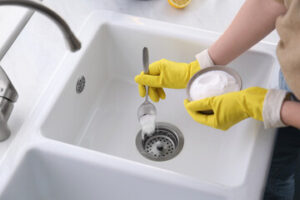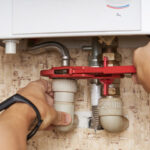Home » Articles posted by Carol Woods
Author Archives: Carol Woods
Turning Wrenches into Careers: Tips and Tricks for Pursuing a Plumbing Profession
The plumbing system in a building performs two basic functions: distributing water and removing waste. This means plumbing systems must be designed and constructed for longevity and resistance to corrosion, damage, and other problems. For more information, click the Website to proceed.
A career in plumbing requires a combination of education and hands-on training, which can be obtained through technical or trade schools or apprenticeships.
While many high school grads assume that they need to attend college to build their career, the reality is that several trades offer more approachable paths to success. One of these is plumbing, which combines the opportunity to earn a good salary with the prospect of working on essential infrastructures that support people’s health and well-being.
Many vocational schools offer certificate and diploma programs in plumbing that can be completed in just a few years. These programs include classroom instruction and hands-on experience, allowing students to learn the basics of plumbing theory and practice. Some even prepare students for certification exams, giving them a leg up on the competition once they enter the workforce.
Most plumbers, however, gain their skills through apprenticeship programs that can last four or five years. These combine classroom learning with on-the-job training, which provides a chance to learn from seasoned plumbers while also earning an income. The advantage of an apprenticeship is that it offers a pathway to becoming a journeyman plumber and eventually a master plumber, all without the burden of student debt that comes with a traditional university degree.
In addition to classroom and on-the-job training, most plumbers undergo extensive safety training. This includes the Occupational Safety and Health Administration’s (OSHA) 30-hour training course, which is usually a part of any plumbing education program. Some also choose to take classes and workshops offered by professional organizations in the industry, like PHCC or ASPE.
Whether you start your plumbing career in school or through an apprenticeship, you’ll need to be familiar with all of the tools of the trade in order to succeed. This includes both hand and power tools as well as the necessary materials to perform various tasks, like installing toilets and showers or repairing faucets and tubs.
A plumbing career can be incredibly rewarding, especially in New York. It can also be lucrative, with salaries well above the national average and with a solid job growth projection. It requires commitment, focus and perseverance, but it can be an excellent alternative to the crowded path of the typical college graduate.
The plumbing industry needs skilled workers to install new systems and repair existing ones. Apprenticeships are an effective way to help aspiring plumbers learn the trade through hands-on, on-the-job experience. These programs can be found through a variety of trade schools, local unions, state training programs and service companies.
Choosing the right apprenticeship program will ensure that an applicant gets the best possible start to their career. Applicants should look for programs that offer a well-defined curriculum that includes classroom instruction, such as OSHA safety and health training, pipe trades mathematics, reading blueprints and isometric drawings, computer-aided design (CAD), steamfitting or refrigeration and air conditioning theory, elements of hydraulics and heat, process pipe welding and plumbing and plumbing-related codes.
Another consideration when selecting an apprenticeship is to choose one that offers opportunities for advancement within the organization and the trade. This will give the apprentice a better chance of advancing to journeyman status and getting paid a higher salary. Moreover, the apprenticeship should provide the apprentice with the opportunity to join a local union and obtain a benefits package that can include sick and personal time pay.
Apprenticeships are an important part of the plumbing business, especially as experienced plumbers retire and need to be replaced. Hiring an apprentice can help a company grow and remain competitive in the market, as well as promote a positive image to customers who see the company supporting its own workforce.
A great place to begin looking for a plumbing apprenticeship is through a local trade school or union. Alternatively, a prospective apprentice can search online for an apprenticeship program. Once an applicant has been selected, they will be placed with a master plumber or other skilled worker and will work under their guidance to learn the ins and outs of the trade.
In addition to training plumbing apprentices on the job, Russell Furr, owner of Culpepper Home Services, also makes it a point to teach them customer service skills. He tells the SharkBite blog that he believes this will help his techs grow to be successful in the long run.
The state requires all professional plumbers to be licensed. Obtaining a license can be as simple as completing an apprenticeship program and passing an exam. Some states require a higher level of work experience and certification, such as the master plumber license. Others require specialized skills or knowledge, such as the ability to install medical gas systems. Some also require a business license, workers’ compensation insurance and liability insurance for contractors.
Most prospective plumbing professionals need only a high school diploma to begin an apprenticeship program, which provides on-the-job training and allows them to earn money while they learn. Apprentices will work under a master plumber and acquire the skills and knowledge necessary to pass the state exam. Then, after working for two to four years as a journeyman plumber, they can apply to take the master plumbing exam.
Some states require a separate license for journeyman plumbers and master plumbers, while others offer a single license that covers both residential and commercial plumbing. Regardless of the licensing requirements, all professional plumbers need to be familiar with local plumbing codes and regulations, as well as Federal and state building standards.
Having a solid foundation in the trade is vital for plumbing careers, especially since the field is constantly evolving and changing. Continuing education classes and seminars are available for plumbing technicians to learn the latest techniques and technology. These courses are designed to keep professionals up-to-date and allow them to offer their clients the best possible service.
Aside from ongoing education, it is important for aspiring plumbers to be physically fit to perform their duties. The job can involve a lot of standing and walking, as well as heavy lifting. It is also crucial to be detail oriented and comfortable with the idea of working in tight spaces. A strong desire to succeed is also necessary, as is the ability to interact with customers in a friendly, helpful manner. To be successful as a plumber, you will need excellent communication and problem-solving skills.
Plumbing is a trade that uses pipes to transport water from its source to a building’s occupants and to remove wastewater and dispose of it in a safe manner. It is important to understand how plumbing works in order to maintain a functioning plumbing system and to prevent problems like leaky faucets, blocked drains, and more.
Plumbers work in a variety of environments, including residential, commercial, and industrial settings. They may also work independently as contractors or in larger companies that specialize in specific areas of plumbing.
The work environment in the plumbing field can be physically challenging. It requires a high level of physical strength and endurance, as well as the ability to work in awkward positions for extended periods of time. The work can be stressful, especially when it involves emergency situations. Plumbers must be able to listen carefully to customers’ concerns and respond in an effective way. They must also be able to read and interpret blueprints, as well as follow all safety regulations when working with machinery, tools, and chemicals.
Many plumbers choose to pursue further education after earning a high school diploma or equivalent. This can be done through a number of options, including community colleges, technical schools, and trade schools. These programs can provide additional training in specialized areas of plumbing and offer certifications. Courses may include topics like local plumbing codes and regulations, blueprint reading, math and physics, and welding.
Plumbers can also learn on the job from more experienced colleagues. Many experienced plumbers will often mentor younger employees and share their knowledge and expertise. This can help newcomers to the industry gain a foothold and succeed in their careers.
Plumbing work can have a positive impact on people’s lives by providing them with access to clean drinking water and by safely disposing of waste. Without these systems, life would be much more difficult for many people. This is why it is so important for plumbers to keep up with maintenance and repair work.
The first step in creating a job posting for a plumber is to write a clear and concise description of the position and what qualifications are required. It is also important to include a salary range, as this will allow applicants to determine whether the role is a good fit for them.
Drain Cleaning: How to Get Rid of Clogged Drains Without Calling a Plumber
Drain Cleaning Tampa is important to prevent clogs, blockages, and leaks. Regularly cleaning your drain pipes can also extend the life of your existing pipes.
Eco-friendly drain cleaners are made with natural or green ingredients and are available in gel form. They are a little slower to work than caustic chemical drain cleaners.
Clogged drains are not just messy, but they can also be dangerous. They can create an ideal breeding ground for bacteria and other harmful microorganisms and can result in sewage back up and flooding your home. However, with a little knowledge of what causes clogged drains and some simple preventive measures, you can keep your home’s drains clear and running smoothly.
Hair, soap scum, mineral deposits, and other debris can clog sinks, showers, and tubs. Using a plunger or commercial drain cleaner often works to remove these items, but if the clog is caused by an object that is too large to be removed with a plunger, you may need to disassemble the drain trap or use a sewer snake.
Most drain clogs form over time as grease, hair, and other waste stick to pipe walls. The best way to prevent these clogs from occurring is to be vigilant about what goes down the drain and to dispose of waste properly. If you notice that a drain is slowing down or not functioning at all, it’s important to address the issue immediately, as it will only get worse.
Kitchen drains often clog due to food scraps, cooking oil, and other fatty substances that are rinsed down the drain. If these materials solidify, they can clog the entire pipe. You can prevent these clogs by not rinsing fats down the drain and by disposing of fatty foods in the garbage.
Bathtub, sink, and toilet drains can also become clogged due to the buildup of soap scum and other debris. To help avoid this, you can regularly clean your drains by pouring boiling water down them. This can help dissolve soap scum and other debris and will also clear hair clogs.
Another way to clear a mildly clogged drain is by mixing baking soda and vinegar. This is a natural and safe method for cleaning your drains, and it can be used in place of chemical drain cleaners, which are toxic and can damage your pipes. To try this, simply heat up a kettle of boiling water and slowly pour it down the drain, allowing a few seconds between each cup.
Clogged Toilets
Clogged toilets can be extremely unpleasant to deal with, especially if the clog prevents you from flushing. However, most clogs in a toilet can be cleared without the use of a plumber or expensive plumbing tools. First, try using a plunger to dislodge the clog. If this doesn’t work, try filling a bucket with hot bath water (not boiling, as this can crack porcelain) and pouring it into the toilet from waist level. This will sometimes dislodge or loosen the clog enough to allow it to pass through the trap and flush away. If this doesn’t work, you can also try prodding the clog with a wire coat hanger. Be very careful when doing this; you don’t want to accidentally break off a piece of the porcelain toilet bowl!
Another possible cause of a clogged toilet is a blocked toilet vent. These vents are built into toilets to help them build up pressure for strong, clog-preventing flushes. If the vent becomes clogged, the resulting backpressure can force waste into other toilets in your home and even cause them to overflow. It’s important to clean up any debris regularly to prevent this from happening.
A final potential problem is a clogged sewer line. Every drain in your house eventually leads to this line, which carries waste out of your home and into the municipal sewage system or your septic tank. Debris can accumulate in the lines from inside or outside your home when tree roots get into them. If you have multiple clogged toilets, it may be a sign of an issue with your sewer line.
If you have tried all of the above solutions and your clog persists, it is probably time to call a plumber. You may also want to consider a non-toxic sewer line cleaner, such as enzymes. These cleaners are designed to break down and liquefy matter that clogs drains, such as food particles, grease, human waste, and hair. However, they can take a long time to work and won’t be effective on very stubborn clogs.
Clogged Sinks
If your shower drain or garbage disposal is completely blocked, it’s probably time to call a plumber. However, many clogs are simple and easy to fix without a professional. Here are a few ways you can clean your own drains and keep them from becoming more serious problems.
First, try a plunger. Fill the sink with a few inches of water, then plunge up and down vigorously. Repeat as needed until the clog dissolves and the water flows freely down the drain.
Next, try a mixture of baking soda and vinegar. Pour one cup of baking soda into the sink drain, followed by a cup of white vinegar. Wait for the mixture to work its magic, then flush the drain with more hot water. This combination can break up light clogs and deodorize your home’s drains at the same time.
If the plunger and baking soda combo doesn’t do the trick, you may need to remove your sink trap (the U-shaped section of pipe under your sink). Grab a bucket to catch any overflow, then loosen the fasteners holding the trap in place with a wrench or your fingers. Pull out the trap and inspect it for blockages. Use a bent wire coat hanger to fish out any hair or gunk stuck in the drain. Once the trap is clear, clean it and put it back in place.
Another option is a plastic drain snake, which can be used to unclog hard-to-reach spots in your plumbing. These snakes are flexible and can easily slip down the length of a vertical pipe to cut through clogs or grease buildup. Just be sure to clean your snake after each use and avoid using it on metal pipes.
To prevent a future clog, make sure you regularly clean your drains and use a strainer basket in your kitchen sink to catch food particles. You can also try running boiling water mixed with grease-fighting dish soap down your drains once a week to prevent greasy buildup. And don’t throw any food scraps in the trash can; they could become a breeding ground for dangerous bacteria and cause an overflow.
Clogged Sewers
If you notice that one or more of your drains are slowing down or that your toilet seems to be filling up with water whenever someone uses it, chances are there is a main sewer line clog. Clogs in the main sewer line are more serious than clogs in individual drains since they affect all of the drains in your home that connect to it.
The first thing to do when you suspect a clog in your main sewer line is to turn off the water in your house. This keeps accidental runs of the toilet or running water from contributing to the clog and prevents any water from backing up into your home.
Next, remove the screw-on cap on your home’s cleanout pipe, which is located near where the pipes exit your basement. This will allow you to access the clogged pipe. You can also use a drain snake to break up and dislodge large clumps of debris.
Using hydrogen peroxide can also help dissolve stubborn clogs, though you should always wear gloves and eye protection when handling harsh chemicals. Pour 1 cup of the solution down a blocked drain and wait about 15 minutes. Then, run hot water down the drains to see if the clog has cleared.
If the clog was caused by a buildup of grease, you can try to dissolve it by mixing hot water with some grease-fighting dish soap. You can also pour down a solution of enzyme drain cleaner, which can digest grease and other non-biodegradable materials.
If tree roots are the cause of your clog, you can try to kill them with chemical drain cleaners that are safe for septic systems. Caustic drain cleaners like potash or lye can work well for this purpose, as can caustic soda. If you’re worried about the safety of these cleaners, consider a natural alternative like dichlobenil, which is septic tank-friendly. If these methods don’t work, you may need to contact a professional plumber for a sewer line cleaning. A professional will be able to inspect the clogged sewer line with a video camera to determine what is causing it.

